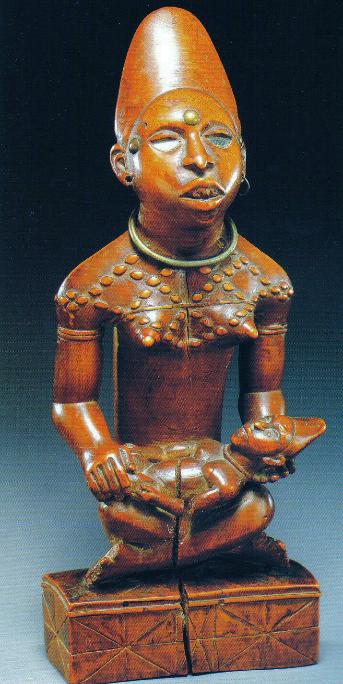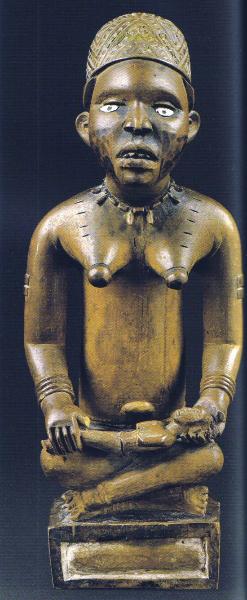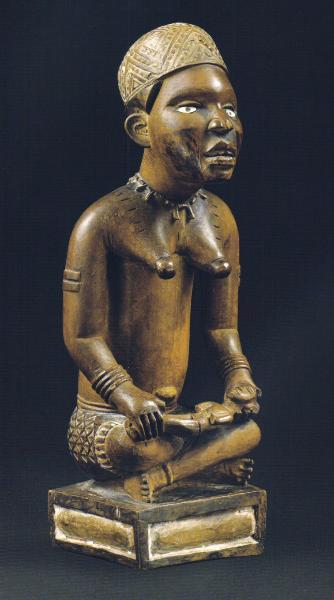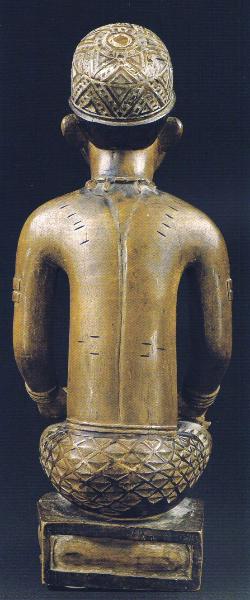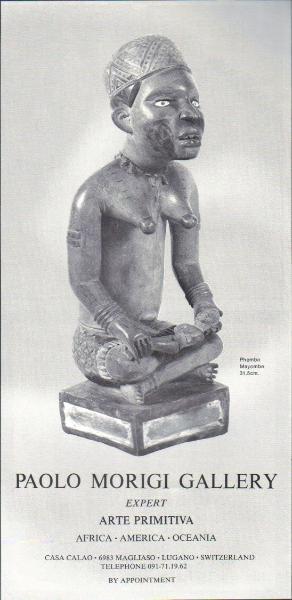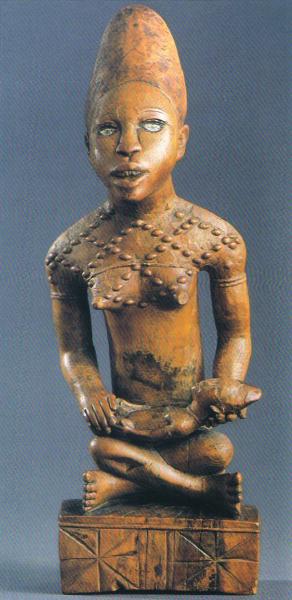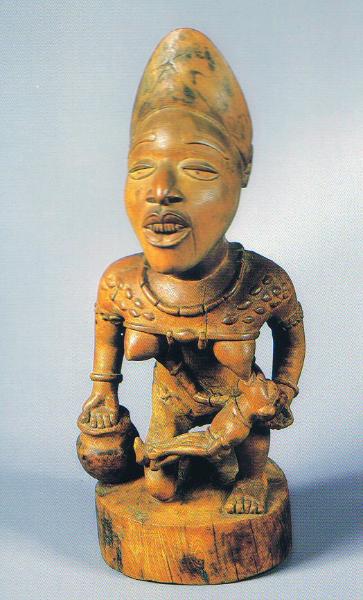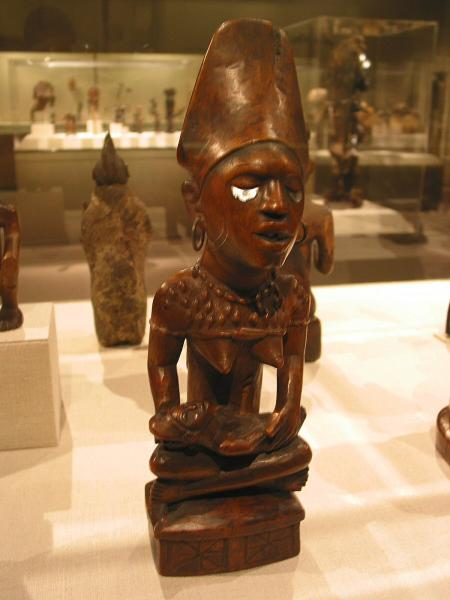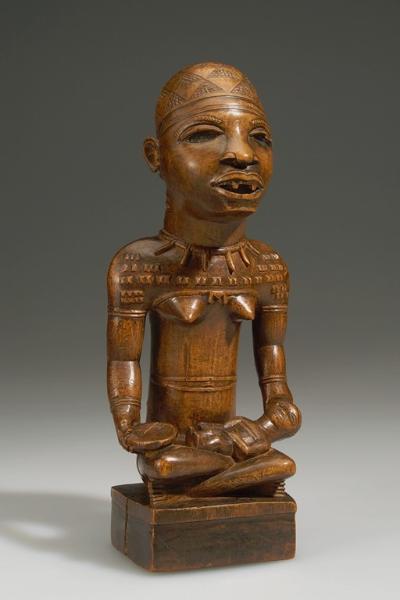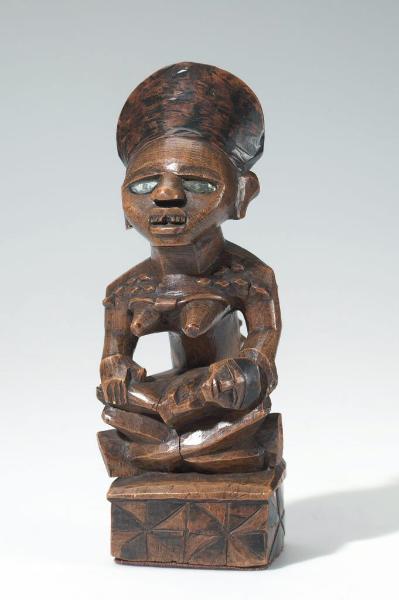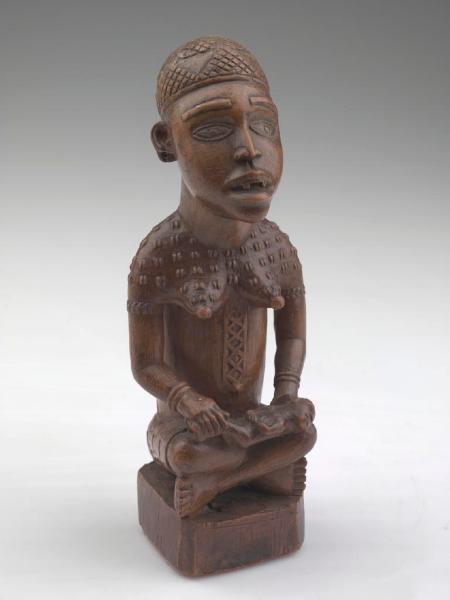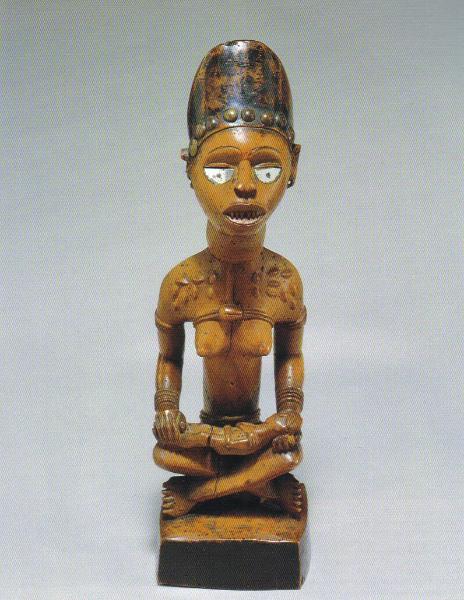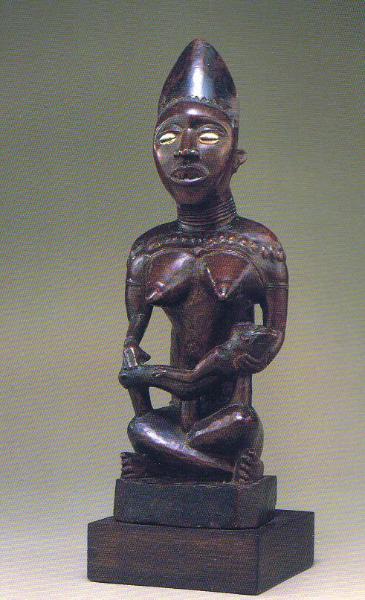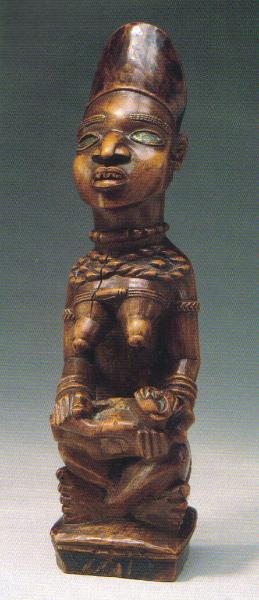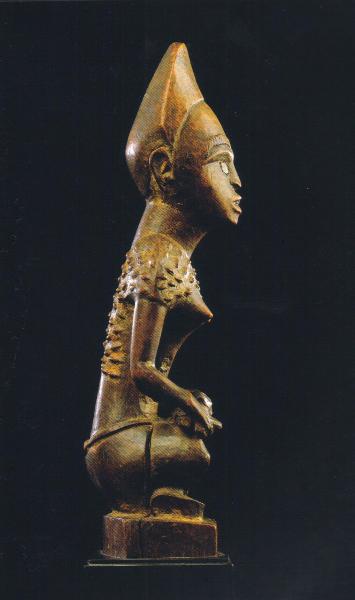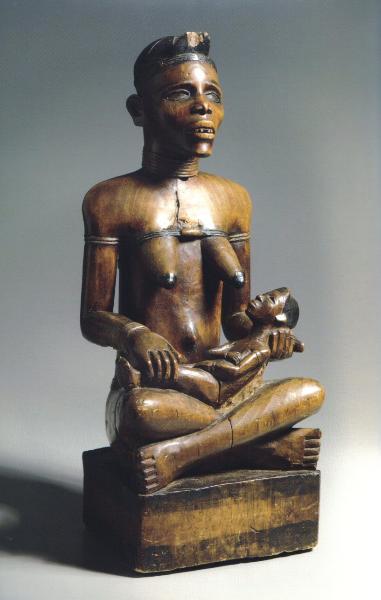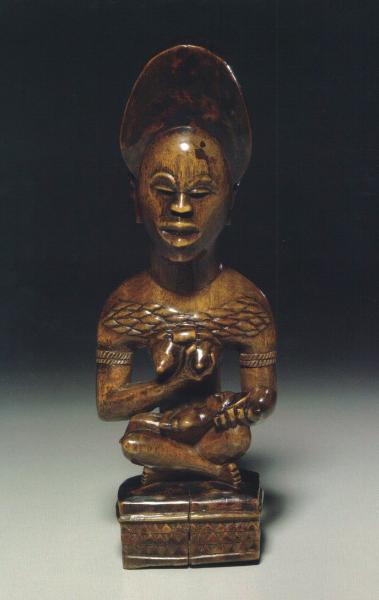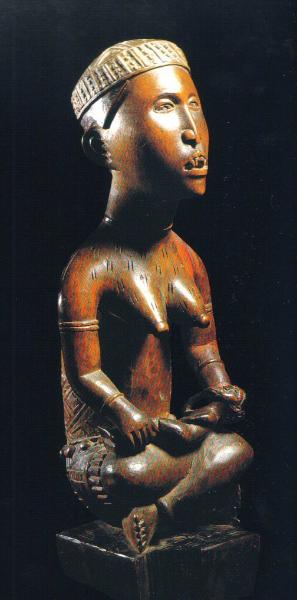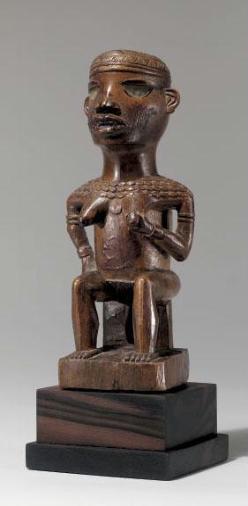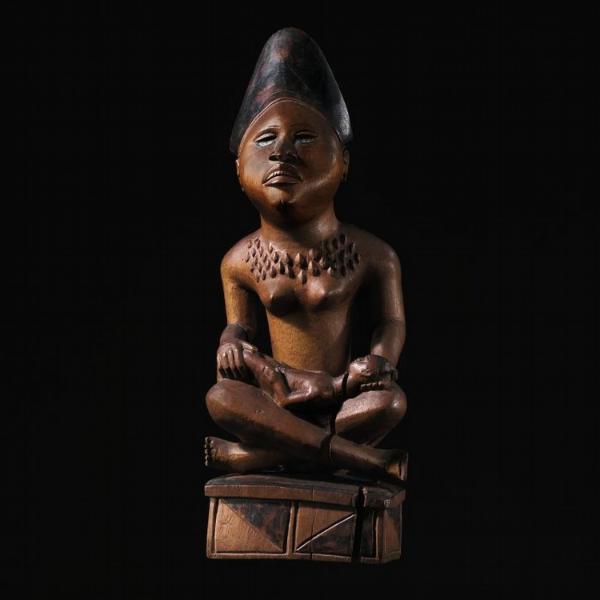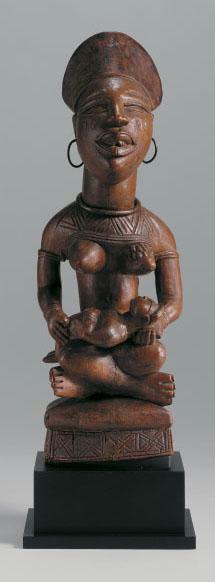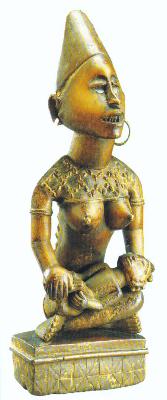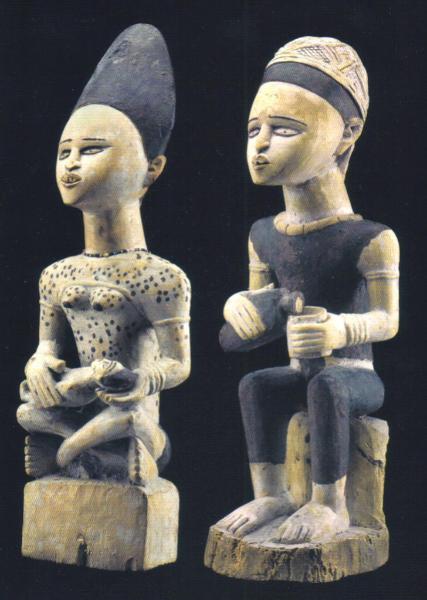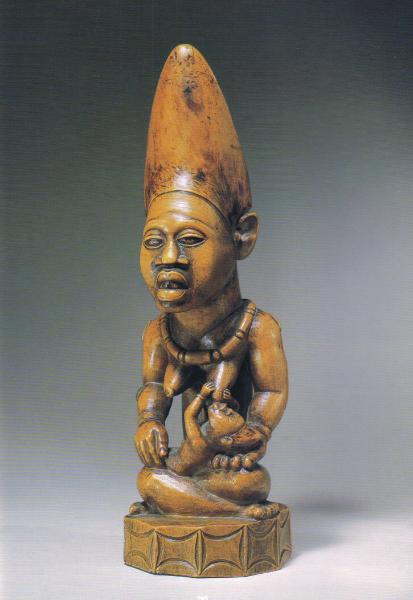
| Yombe maternity figure - Pfemba or Phemba There are a LOT of images on this page |
| THE EXAMPLES BELOW ARE FOR REFERENCE PURPOSES ONLY THESE FIGURES ARE NOT IN MY COLLECTION Other examples of varied styles for reference purposes Maternity figures are among the most renown in African art because of their easily recognizable theme, their classical form and their fine workmanship. Maternity figurines (pfemba) are thought to have first been used in rituals addressing women's infertility, and were decorated in a red paste. In Kongo iconology, the colour red symbolizes transitional phases such as birth and death, as well as ritual practices. The figures' mitred hairstyles are a reminder of a fashion once popular among Mayombe men and women; the knitted bonnet or mpu suggests high rank. Women from this region often had intricate patterns of scarification on their bodies, made by rubbing substances into incisions in the skin. These keloid tattoos increased a woman's sexual appeal — without scarifications a woman might be mocked because she was "as slippery as a fish." Filed teeth also reflect the Kongo ideal of female beauty. Click on most any image to see larger version |

| Female figure with child Kongo peoples Mayombe region, Democratic Republic of the Congo Mid 19th-early 20th century Wood (Nauclea latifolia), glass, glass beads, brass tacks, pigment H x W x D: 25.7 x 10.5 x 10.2 cm (10 1/8 x 4 1/8 x 4 in.) National Museum of African Art |
| The figure of a mother and child is an icon of Kongo art. It is not a simple genre theme, but a statement of the spiritual power supporting society, the need for fertility and the promise of future generations. These figures possibly are connected with mpemba, a women's cult said to have been founded by a famous midwife and concerned with fertility and the treatment of infertility. Mpemba seems to have grown at the same time the slave trade intensified, from 1770 to 1850; an increased concern for children seems a logical development. There are also ties to the Lemba cult, which also arose during the slave trade period, whose members were the wealthy mercantile elite. Lemba was concerned with healing, trade and marriage relations, and it redistributed potentially disruptive wealth among kin and shrines. Inside a special box, members kept significant cult objects including a sack of red pigment, symbolizing the female element, called pfemba lemba. Red pigment originally was rubbed on these figures; only traces remain. Costly and distinctively modeled metal bracelets were a Lemba emblem and may be represented on the figure. The figure is seated, legs crossed, atop a small base. This pose conveys the prestige of high political and social status, as do a number of other details. It is depicted wearing a close-fitting hat, traditionally made of knotted raffia or pineapple leaf fiber. This type of hat was worn by chiefs at the time of their investiture and by noblewomen who would give birth to future rulers. Brass tacks and imported glass beads adorn the figure as well. The imported glass inset in the eyes shares the same glittering aesthetic but also refers to the ability to see the invisible spiritual world. Other attributes of the figure are associated with beauty, perfection and high rank. The chest cord serves to emphasize the breasts. Scarification was viewed as erotic and beautiful; it marked physical maturity and assured conception. The chiseled teeth also were considered beautiful. Examining similar figures makes it possible to identify artists' hands or workshops. Six extant figures are in the style of the figure, all of which have been attributed by Ezio Bassani (1981) to a carver he designates the Master of the de Briey Maternity (Africa Museum, Tervuren, no. 24662). Stylistic differences exist among even these six, and further research on attribution and dating is needed. A final note should be made concerning the child depicted, which looks more like a small adult rather than a real infant. Leo Bittremieux, priest and ethnographer, in a 1939 letter to the Africa Museum in Tervuren, wrote that "Phemba" denotes "the one who gives children-in-potentia." A pfemba child is a magically conceived nkisi child, a fragile emissary of the spirit world. Because the child is unexpressive and supine, it has been described as dead. Since a number of the infants either nurse at or touch their mother's breast, there are either two different subjects or death takes an unusual definition. On this figure, the child holds his penis erect while touching the mother's breast. The gesture could be a reference to fertility, metaphorically referring to the seeds of creation or to the belief that those who die will be reborn. So death, or the spirit world, may not be estranged from life in Kongo beliefs. National Museum of African Art |


| From the book: African Faces, African Figures; The Arman Collection of African Art Maternity Figure: pfemba Kongo-Mayombe Democratic Republic of Congo Wood, leather, metal, mirror H: 31 cm (12.1 inches) Exhibitions: Arts primitifs dans les ateliers d'artistes, Musee de l'Homme, Paris 1967. Masterpieces of the People's Republic of the Congo, Denver 1981. Publications: — Arts primitifs Jans les ateliers d'artistes, Musee l'Homme, Paris, no. 103. — J. Kerchache, L'Art africain, Mazenod, no. 236. — Masterpieces of the People's Republic of the Congo, Denver 1981, no. 9. — R. Lehuard, Le phemba du Mayombe, 1977, no. 26. — F. Willet, African Art, 1971, no. 241, p. 245. |

| A really wonderful figure, I love the expressiveness in the face of this figure. SOTHEBY'S ART AFRICAIN ET OCÉANIEN, COLLECTION PAOLO MORIGI SALE PF5027 AUCTION DATE 06 Dec 05 2:30 PM. LOCATION - Paris LOT 105 IMPORTANTE MATERNITÉ, KONGO/YOMBÉ , RÉPUBLIQUE DÉMOCRATIQUE DU CONGO ESTIMATE 70,000—90,000 EUR MEASUREMENTS haut. 31,5 cm 12 in DESCRIPTION pfemba, représentant une femme assise coiffée d'une calotte hémisphérique, les jambes croisées, les mains aux positions asymétriques tenant l'enfant allongé. Le mouvement simultané du buste - penché en avant - et de la tête - légèrement relevée, met en valeur le visage puissant. Les traits sont réalistes, et très finement modelés : yeux figurés par des éclats de faïence, les pupilles indiquées, paupières supérieures et sourcils délicatement arqués, la bouche ouverte aux lèvres ourlées entrouvertes sur une rangée de dents taillées. Très grande finesse et régularité dans le décor gravé du pagne et de la coiffe. Très belle patine, brun nuancé, avec rehauts de noir de fumée sur le vêtement, les cheveux et les joues, et de kaolin sur la coiffe, dans les creux de la gravure. Condition Note: La partie supérieure de l'enfant cassée, recollée. Un pouce manque. PROVENANCE Ancienne collection Bischofsberger, Zurich LITERATURE AND REFERENCES Reproduite dans : Lehuard, 1989 vol. II : 480 Exposée et reproduite dans : Un' arte par la bellezza : cosmesi e salute nei secoli, 1984 : n°71, catalogue de l'exposition, Padoue et Villa Malpensata, Lugano, octobre- décembre 1984 CATALOGUE NOTE An important Yombe/Kongo maternity figure, Democratic Republic of the Congo In plastic terms, this pfemba maternity figure is remarkable for the great beauty of the head – set off to perfection by the pose – whose fine dimensions create a combination of gentleness, intensity and balance. Lehuard (1989, vol. II: 480 - 481) classifies the sculpture as being in sub-style J 3 of Yombe statuary; in his view, it prefigures "statues carved for use as funerary figures". He characterises this style by the "particular attention paid to the face, which reflects a sort of gentleness", the suppleness of the attitude and the high quality of carving in the details. On the subject of the Paolo Morigi maternity figure, he also stresses a mark in relief of two superimposed rectangles "never seen before". |
| An ad that I came across that featured this piece in the Paolo Morigi Gallery in the November 1981 African Arts publication |
| Image above from the book: To cure and Protect - Sickness and Health in African Art Mother and Child. Yombe, Kongo peoples, Congo (Brazzaville), Congo (Kinshasa), Angola. Wood, H. 16 in. Private collection. |
| From the book: Art of Central Africa - Masterpieces from the Berlin Museum für Völkerkunde KNEELING WOMAN AND CHILD Congo and Zaire; Yombe, 19th century Wood, H. 11 3/4 in. (30 cm.) Gift of Wilhelm Joest, 1896 III C 6286 Figures representing a woman with a child are common in the art of the Kongo peoples of Lower Zaire, especially among the Yombe. The mother is often depicted with the marks of high social status and consciously acquired beauty: a high miter-shaped hairstvle, hied teeth, a necklace of glass or coral beads, a cord tied above the breasts, and bracelets and armbands. Although such figures are usually depicted seated with crossed legs, this one crouches with one knee on the ground, the other raised. The baby, who nurses eagerly at one breast and reaches toward the other, lies awkwardly across the mother's lap, its head cupped in her hand. The mother rests her other hand, palm upward, on a pottery jar at her side. A Yombe wooden mother-and-child figure in the Musee Royal de l'Afrique Centrale in Tervuren is reported by its collector, Leo Bittremieux, to have been owned by a powerful male diviner for whom it represented the source of his own divinatory and generative powers. It was called phemba, a word that Bittremieux thought to be derived from kivemba, meaning to broadcast or eject, as in the seeds of potential children which accumulate in either a man or a woman. Thus, rather than representing a particular woman and child, or even a concept as specific as motherhood, the Yombe image of a nurturing woman may express the more general idea of fertility and creativity as it applies to all people, male as well as female (Maesen 1960: pi. i; van Geluwe 1978: 147-50). The figure was given to the Berlin museum by Wilhelm Joest (1852-98), an anthropology professor whose vast collection of objects from around the world formed the basis for the Rautenstrauch-Joest Museum in Cologne. HJK/KE |

| Kongo peoples Democratic Republic of the Congo, Congo, Cabinda Province, Angola Late 19th-early 20th century Wood, brass tacks, pigment H x W x D: 24.8 x 8.6 x 7.6 cm (9 3/4 x 3 3/8 x 3 in.) National Museum of African Art |
| The figure of a mother and child is an icon of Kongo art. It is not a simple genre theme, but a statement of the spiritual power supporting society, the need for fertility and the promise of future generations. These figures possibly are connected with mpemba, a women's cult said to have been founded by a famous midwife, and concerned with fertility and the treatment of infertility. Mpemba seems to have grown at the same time the slave trade intensified, from 1770 to 1850; an increased concern for children seems a logical development. There are also ties to the Lemba cult, which also arose during the slave trade period, whose members were the wealthy mercantile elite. Lemba was concerned with healing, trade and marriage relations, and it redistributed potentially disruptive wealth among kin and shrines. Inside a special box, members kept significant cult objects including a sack of red pigment, symbolizing the female element, called pfemba lemba. Red pigment originally was rubbed on these figures; only traces remain. The figure is seated, legs crossed, atop a small base. This pose conveys the prestige of high political and social status, as do a number of other details.The flaring hairstyle is also a traditional perquisite of high status, a standing reinforced by the presence of imported European brass tacks, a precious trade item. The imported glass originally inset in the eyes shared the same glittering aesthetic but also refers to the ability to see the invisible spiritual world. Other attributes of these figures are associated with beauty, perfection and high rank. The chest cord serves to emphasize the breasts. Scarification was viewed as erotic and beautiful; it marked physical maturity and assured conception. The chiseled teeth also were considered beautiful. A final note should be made concerning the child depicted, which looks more like a small adult rather than a real infant. Leo Bittremieux, priest and ethnographer, in a 1939 letter to the Africa Museum in Tervuren, wrote that "Phemba" denotes "the one who gives children-in-potentia." A pfemba child is a magically conceived nkisi child, a fragile emissary of the spirit world. Because the child is unexpressive and supine, it has been described as dead. Since a number of the infants either nurse at or touch their mother's breast, there are either two different subjects or death takes an unusual definition. On one figure, the child holds his penis erect while touching the mother's breast. The gesture could be a reference to fertility, metaphorically referring to the seeds of creation or to the belief that those who die will be reborn. So death, or the spirit world, may not be estranged from life in Kongo beliefs. National Museum of African Art |

| Kongo peoples Mayombe region, Democratic Republic of the Congo Late 19th-early 20th century Wood, metal, brass tacks, resin, pigment H x W x D: 24.4 x 9.2 x 8.9 cm (9 5/8 x 3 5/8 x 3 1/2 in.) National Museum of African Art |
| The image of mother and child is an icon of Kongo art. It is not a simple genre theme, but a statement of the spiritual power supporting society, the need for fertility and the promise of future generations. Mother-and-child figures possibly are connected with Mpemba, a women's cult concerned with fertility and the treatment of infertility, which is said to have been founded by a famous midwife. Mpemba seems to have grown at the same time the slave trade intensified, from 1770 to 1850; an increased concern for children seems a logical development. This type of figure may also have ties to the Lemba cult, which arose during the slave trade period and whose members were the wealthy mercantile elite. Lemba was concerned with healing, trade and marriage relations, and it redistributed potentially disruptive wealth among kin and shrines. Inside a special box, members kept significant cult objects including a sack of red pigment, symbolizing the female element, called pfemba lemba. Red pigment was once rubbed on this figure; only traces remain. Costly and distinctively modeled metal bracelets were a Lemba emblem and may be represented by the bracelets carved on this figure. The mother figure is seated, legs crossed, atop a small base. This pose conveys the prestige of high political and social status, as do other details including metal earrings and a representation of a leopard-tooth necklace. The mother is depicted wearing a close-fitting hat traditionally made of knotted raffia or pineapple leaf fiber. This type of hat was worn by chiefs at the time of their investiture and by noblewomen who would give birth to future rulers. Brass tacks adorn the figure as well. Other attributes of the figure are associated with beauty, perfection and high rank. The chest cord serves to emphasize the breasts. Scarification was viewed as erotic and beautiful; it marked physical maturity and assured conception. The chiseled teeth also were considered beautiful. National Museum of African Art |
| Yombe maternity figure Metropolitan Museum of Art, NY |
| American Museum of Natural History, NY FIGURE, FEMALE/CHILD [90.2/ 5048] AFRICAN ETHNOGRAPHIC COLLECTION Culture: KONGO Country: ANGOLA? Material: WOOD, PIGMENT, MIRRORED GLASS Dimensions: L:9.4 W:7.8 H:23 [in CM] Donor: LANBIN Acquisition Year: 1965 |
| American Museum of Natural History, NY FIGURES, FEMALE, CHILD [90.2/ 5047] AFRICAN ETHNOGRAPHIC COLLECTION Culture: KONGO Country: ZAIRE?, CONGO? Material: WOOD,GLASS,STAIN,PIGMENT,CLOTH(FELT) Dimensions: W:9.3 H:24.7 [in CM] Donor: LANBIN Acquisition Year: 1965 |
| American Museum of Natural History, NY FIGURES, FEMALE/CHILD [90.2/ 5049] AFRICAN ETHNOGRAPHIC COLLECTION Culture: KONGO Country: ANGOLA? Donor: LANBIN Acquisition Year: 1965 |


| Photos (not very good ones) that I took of the display of the Yombe figures at the American Museum of Natural History in NY in May 2005 |

| Sotheby's Property from the Mr. and Mrs. Klaus G. Peris Collection of Tribal Art Lot 31 May 1995 A Yombe Female Figure, seated on a stool with one hand resting on the knee and the other holding a container, the full hips beneath a slender columnar torso with prominent navel and conical projecting breasts, with a forward-thrust¬ing elliptical head with oval eyes inset with white porcelain, and wearing a tapering conical headdress banded by a dec¬orative sash with a cowrie shell carved at the front, two strings of black beads around the neck; fine aged honey brown patina. Height 9 in. (22.9 cm.) Provenance: JJ. Klejman, New York, 1974 estimate $5,000-7,000 sold $3500 |
| Sotheby's Property of an East Coast Private Collector Lot 126 - May 1996 A Superb Yornbe Maternity Figure, seated on a square base, the crossed legs with flattened enlarged feet beneath a cylindrical torso with conical breasts, and the rounded shoulders issuing elongated arms terminating in naturalistic hands holding an elongated baby lying on its back, the female with an elongated neck, an enlarged head with pointed chin, and open mouth showing incised triangular teeth, the naturalistic triangular nose between semi circular hollowed eyes inset with mirrors under domed brow, the high forehead with incised curved eyebrows, framed by flared elongated pierced ears, all beneath a high upraised flattened coiffure inset with brass nails, carved bracelets encircling the wrists, and necklaces around the waist and breast, raised scarification on the torso and back; dark brown patina on the base and the coiffure, fine light brown patina. Height 127/sin. (32.7cm.) Provenance: The British Museum, London Ralph Nash, London JJ. Klejman, New York For a comparison of styles of Yombe maternity figures see Kercbache, The Art of Africa, 1993:figs. 233-236. estimate $25,000-35,000 |
| Sotheby's - The Kuhn Collection of African Art - November 1991 Lot 86 A Yombe Maternity Figure, phemba, seated on a square base with powerful legs crossed and delineated toes pointed to the front, supporting a forward-projecting torso with enlarged conical breasts framed by sloping oversized shoulders and slender forearms, holding an attenuated infant with upturned head and classical features in her hands, held above the mother's lap by three cylindrical bridges emerging from her legs, surmounted by a ringed arched neck and classically carved oval head, with squared chin, lobed mouth revealing filed teeth, pronounced triangular nose and cowrie-shell inset eyes beneath arched brows, serrated browline and tall upswept coiffure, oblong scarification across her upper chest and back, arched and notched scarification also on the upper back; fine smooth reddish-brown turning to black patina. Height 15'/4 in. (38.7 cm.) Provenance: Gaston de Havenon, New York Marc and Denyse Ginsberg, New York Literature: Gillon, 1979, fig. 123 Lehuard, 1989," vol. II, p. 571, illus. Exhibited: Los Angeles, California, Los Angeles County Museum of Art, The Mother and Child in African Sculpture, December 5, 1985-July 6, 1986 Thompson and Cornet, 1981, pp. 166—7, discuss the relevance of the sitter's position both in terms of its Kon-goese significance as well as its ramifications in other cultures outside of Africa as follows: "Let us begin with the cross-legged seated position (funda nkata), radiantly exemplified by a mother and child in wood in the collection of Count Baudoin de Grunne [referring to a related example, fig. 141]. Provisionally, it would appear that this courtly gesture lacked the staying power of attitudes more widely disseminated through Kongo culture. Nevertheless, funda nkaka appears early in the nineteenth century in Kongo Square, New Orleans: 'the performer, sitting cross-legged, held the [mibira] in both hands and plucked the end of the reeds with his thumbnails.' This scene recalls a common theme of Kongo sculpture. Elsewhere in the Americas, a scholar of black life in Trinidad, Jacob Elder, remembers that on that island, in this century, 'there was an old Kongo man, who shaved his head and sat cross-legged.' He sat in this manner, so it was recalled, 'thinking of his ancestors.'" estimated $50,000-70,000 This figure was not sold and ended up being donated by the Kuhn's to the National Museum of African Art (see below) |

| Kongo peoples Mayombe region, Democratic Republic of the Congo Late 19th-early 20th century Wood, cowrie shells, pigment H x W x D: 38.8 x 14.5 x 13.9 cm (15 1/4 x 5 11/16 x 5 1/2 in.) Gift of Jeffrey and Candace Kuhn National Museum of African Art The image of a mother and child is an icon of Kongo art. It is not a simple genre theme, but a statement of the spiritual power supporting society, the need for fertility and the promise of future generations. These types of figures possibly are connected with Mpemba, a women's cult said to have been founded by a famous midwife and concerned with fertility and the treatment of infertility. Mpemba seems to have grown at the same time the slave trade intensified, from 1770 to 1850; an increased concern for children seems a logical development. The figures may also have ties to the Lemba cult, which arose during the slave trade period and whose members were the wealthy mercantile elite. Lemba was concerned with healing, trade and marriage relations, and it redistributed potentially disruptive wealth among kin and shrines. Inside a special box, members kept significant cult objects including a sack of red pigment, symbolizing the female element, called pfemba lemba. Red pigment was rubbed on the figures, as is suggested by the deep reddish tone of this example. The mother figure is seated, legs crossed, atop a small base. This pose conveys the prestige of high political and social status, as do a number of other details. The hairstyle is a traditional perquisite of high status. One of the most striking aspects of this figure is the use of cowrie shells for eyes, rather than inset glass or mirror. Their use is less common in collected examples but is not atypical of the region and may represent an older tradition. Cowrie shells are usually references to wealth since they functioned as currency. This would be in keeping with the figure's chiefly associations. However, among the Kongo peoples, cowries also have a connection to spiritual powers. Cowrie shells, like mirrors and glass, have a shining, reflective or white surface. Their reflective quality allows those with special powers--chiefs, diviners and healers--to "see" into the spirit realm. That is why cowries were used as eyes on figures or to seal medicine containers. Other attributes of this figure are associated with beauty, perfection and high rank. The chest cord serves to emphasize the breasts. Scarification was viewed as erotic and beautiful; it marked physical maturity and assured conception. The chiseled teeth also were considered beautiful. The child depicted looks more like a small adult than an infant. Because the child is unexpressive and supine, it has been described as dead. Since many of the infants in this type of figure either nurse at or touch their mothers'breasts, this is either a different subject or death takes an unusual definition. On a similar figure, the child holds his penis erect while touching the mother's breast. The gesture could be a reference to fertility, metaphorically referring to the seeds of creation or to the belief that those who die will be reborn. So death, or the spirit world, may not be estranged from life in Kongo beliefs. |
| Sotheby's May 1994 Property sold for the Benefit of The Mazes S. Schupf Foundation, Inc. Lot 155 A Yombe Maternity Figure, seated cross-legged and holding a child on her lap, with carved bracelets encircling her wrists, a carved thong around the upper torso and a half skirt around her buttocks, her neck encircled by a carved necklace, her upturned head with mirrors inset for eyes beneath an upswept blackened headpiece, scarification in a diamond motif on the upper torso; fine honey brown patina. Height 121/4 in. (31.1cm.) Provenance: J.J. Klejman, New York Several iconographical elements of this figure—the coiffure, the treatment of the face, and the scarification on the upper torso— suggest that she belongs in the group of Yombe maternities that Lehuard (1989: 571-578) has designated sub-style K5. estimate $6,000-9,000 (sold for $4888) |
| From the Pierre Dartevelle Gallery - Brussels, Belgium As seen in the Bruneaf 2005 catalog Yombe maternity, 29cm, collected 1910 Ex collection Mylonas |
| From the book: South of the Sahara MOTHER-AND-CHILD FIGURE; YOMBE PEOPLE, DEMOCRATIC REPUBLIC OF THE CONGO LATE I9TH TO EARLY 2OTH CENTURY; WOOD; HEIGHT 64.7 CM LEONARD C. HANNA JR. FUND 1997.149 - Cleveland Art Museum The Yombe are one of the many Kikongo-speaking peoples that at one point in their history were part of, or strongly influenced by, the former kingdom of Kongo. This kingdom on the Atlantic Coast near the mouth of the Kongo River flourished from at least 1400 through the late 1600s. Its hilltop capital Mbanza Kongo, present-day Sao Salvador in Angola, was first visited by Portuguese explorers in the mid fifteenth century. Luxury goods and refined art works enhanced the divine character of the Kongo king. After the introduction of Christianity and the baptism of King Nzinga a Nkuwa on 3 May 1491, Kongo artists were influenced by the iconography of the new faith. The mother-and-child theme and the naturalism in Yombe art may also reflect the influence of European models and tastes. This mother-and-child figure probably comes from the region around the village of Kasadi in the Democratic Republic of the Congo. It is stylistically related to three face masks and six maternity figures of smaller size. The mother-and-child figures have been attributed to a single artist whom scholars have named the "Kasadi Master." Marc Felix, however, has recently identified the Cleveland figure as the work of an unknown artist of the Sundi, another Kikongo-speaking people about which little is known. While small Yombe mother-and-child figures were mainly used in a women's cult concerned with the treatment of infertility, the size and soft wood of the Cleveland figure— which was originally brightly colored—indicate its funerary function. Since it does not show the weathering that prolonged exposure on a tomb would have caused, the figure was most likely placed in a roofed ancestral shrine. The cross-legged seated pose atop a square base and the various body adornments, including the cord tied above the breasts and the patterned cap with tab-like projection, convey high social status, and may reveal that the woman represented incarnates the founding ancestor of a descent group. |
| From the book: South of the Sahara MOTHER-AND-CHILD FIGURE (pfemba); POSSIBLY YOMBE PEOPIE, DEMOCRATIC REPUBLIC OF THE CONGO MID TO LATE 19TH CENTURY; WOOD; HEIGHT 26 CM ANDREW R. AND MARTHA HOLDEN JENNINGS FUND 2003.35 - Cleveland Art Museum Thanks to their refined naturalism and recognizable theme, mother-and-child figures of the Yombe and related peoples of the Lower Congo region are among the most beloved types of African art in the West. This figure is most probably an example of a type of sculpture called pfemba that is related to a women's cult concerned with enhancing fertility and the treatment of infertility. Oral tradition holds that the pfemba cult was established by a famous midwife. The very different styles of the two sculptures illustrate regional and even personal variations on the same theme. The figure depicted here also held a high rank in society, as testified by her cross-legged pose on a pedestal and her many body adornments. The chiseled teeth, the firm breasts, the miter-shaped hairstyle, which imitates a once-popular coiffure among both men and women, and especially the raised scarification marks indicate ideals of beauty and perfection. Meant to stimulate sexual pleasure, the scars were considered both beautiful and erotic. The double bracelets around her upper arms imitate protective charms called nsunga; made of plaited or braided raffia fibers, they are worn by religious experts and by ill people as a cure. During their ritual use, the surfaces of figures such as this one were rubbed with a reddish mixture of oil and camwood powder, both a cosmetic and a sign of mediation. It is no coincidence that inYombe thought the color red indicates transitional conditions such as death and birth. The fact that some mother-and-child figures hold or carry what appears to be a dead baby alludes to the close interrelationship in Kongo beliefs between the spirit world and the world of the living. It has been suggested that the figures were thoroughly cleaned and polished after their use by their original caretakers. The resinous material on many examples in Western collections seems to have been applied not by the people who made and used them but by their first Western owners. |
| From the book: The Tribal Arts of Africa Yombe maternity figure wood; height; 36 cm (11 1/4 in) This superb example of Kongo sculpture shows the emphasis given to the head with its filed teeth and to the characteristic back scarifications. This female figure embodied a gentler spiritual force than the threatening male figures and was used for fertility rituals. |

| Sotheby's - New York Arts of Africa, Oceania & The Americas Auction Date : May 17, 2002 Lot 122 : A YOMBE SEATED FEMALE FIGURE Description seated on a square plinth, the barrel-like torso with broad shoulders and back elaborately decorated with cicatrices, the thin arms with one hand on the hips the other holding her breast, the expressive face with inset glass eyes and wearing an incised flat cap-like coiffure; fine honey brown patina with areas of red resin. Estimate:$ 10,000 - $ 15,000 Price Realized:$ 0 Provenance Pierre Dartevelle, Brussels |
| Sotheby's - Paris Paolo Morigi collection : Important African Art Auction Date : Jun 6, 2005 Lot 175 : f - MATERNITÉ, KONGO/YOMBÉ, RÉPUBLIQUE DÉMOCRATIQUE DU CONGO [A KONGO/YOMBE MATERNITY FIGURE, PROVENANCE Ancienne collection Stocklet (années 1930) Ancienne collection de Madame Morley, Bruxelles Dimensions haut. 23 cm 9 in Estimate:€ 35,000 - € 40,000 Price Realized: € 0 |

| Sotheby's - Paris Paolo Morigi collection : Important African Art Auction Date : Jun 6, 2005 Lot 168 : f - MATERNITÉ, KONGO/YOMBÉ, RÉGION DU BAS-CONGO, RÉPUBLIQUE DÉMOCRATIQUE DU CONGO PROVENANCE Ancienne collection G.K. Keller (inv. G.F.K. 357), acquise vers 1978 LITERATURE AND REFERENCES Jacob, 1978 : 42 CATALOGUE NOTE A Kongo/Yombe maternity figure, Lower Congo area, Democratic Republic of the Congo In the corpus of pfemba maternity figures, it is rare that the child is not carved in a lying position. The position of a supine child, lead scholars to hypothesize that the babies represented were dead. Pfemba's shown with a child breastfeeding or on bent knees are a sign of vitality, suggesting links with a fertility cult (MacGaffey in Tervuren, 1995: 290). The offer lot is exceptional in the context of known pfemba as the child is carved fully frontal, solidly settled in his mother's lap, and very much alive. A number of rare examples are known showing the child standing along side of the mother (Lehuard, 1989:558), or seated (ibid.:580), or the mother feeding her child (ibid.:471), The Völkerkunde Museum, Zurich (ibid.: 477), or another, formerly in the collection of Hubert Goldet (ibid.: 486), another from The Museum of Ethnography in Saint Gallen (ibid: 515), collected in the 1924 from a private collection. This last pfemba is exceptional for the vitality in the attitude of the child, carved facing forwards, firmly resting on the knees of his mother. Plastically, the maternity from the Morigi collection is unusual for the impression of dignity suggested by the pose and the elongated torso, as well as the beautiful serenity of the face associated with sadness, but realistic in its details. Cf. Kerchache, Paudrat and Stephan (1988:345, n 236), Willett (1971, 245, n 241) and Lehuard (1989: 574, n K 5-1-7) for a maternity stylistically comparable from the Arman collection, identified by Lehuard as from the sub style K5 in his classification of Yombe statuary (ibid.:571-578). Dimensions haut. 31 cm 12 1/3 in Estimate:€ 45,000 - € 60,000 Price Realized: $ 46,265 € 38,400 |
| Sotheby's - New York African, Oceanic and Pre-Columbian Art Auction Date : May 12, 2005 Lot 86 : PROPERTY FROM A NEW YORK PRIVATE COLLECTION A FINE YOMBE MATERNITY FIGURE Description phemba, seated on a square base, the powerful crossed legs supporting the languid baby cradled at the head and feet, the torso, with scarification in high relief at the chest and back, leaning slightly to the right, with broad rounded shoulders and neck, the head, strongly pitched forward, with downturned mouth baring teeth, straight nose and crescent eyes of inset glass framed by ears finely carved in a scroll motif beneath the tall lanceolate coiffure; aged honey brown patina with areas of pokerwork. PROVENANCE J. J. Klejman, New York CATALOGUE NOTE The offered figure compares most closely to another in the collection of the Brooklyn Museum of Art (see Lehuard 1989: 581, figure K 6-1-4). In addition to the faceted, tall base, the figures share the idiosyncratic qualities of an exceptionally broad neck gently sloping outward to the jawline and abstract scrolling ears. Lehuard places the Brooklyn figure in sub-cateogory six, characterized by particularly amplified expressionistic qualities including--the pitch of the head, the shape of the mouth and rendering of the teeth, the aquiline nose and strong jawline. Yombe maternity figures were used in association with women's fertility cults. Originally they were covered with camwood powder, or tukula. Red powder was used as red is the color symbolic of life's transitions, such as birth and death. The posture itself, a seated figure holding a child across the crossed legs has broad symbolic signficance as it traveled well beyond the Kongo, even to America. The funda nkata appeared in Kongo Square, New Orleans in the early 19th century, according to Thompson and Cornet (1981:166-167). The gesture also implies 'thinking of the ancestors'. Dimensions height 15 1/8 in. 39cm Estimate: $ 25,000 - $ 35,000 |

| Sotheby's - New York Arts of Africa, Oceania & The Americas Auction Date : May 17, 2002 Lot 121 : A YOMBE KNEELING FIGURE Description kneeling on a square base, and wearing a loin cloth, the resin power bundle with a mirror at the center, the face with typical features and eyes inset with glass and wearing a conical coiffure inset with studs; honey brown patina. Estimate:$ 12,000 - $ 18,000 Price Realized: $ 0 |
| Sotheby's - New York Arts of Africa, Oceania & The Americas Auction Date : May 17, 2002 Lot 139 : A SUPERB YOMBE MATERNITY FIGURE Description phemba, seated on a square base with incised quatrefoil designs, her bent arms holding a baby resting on her lap, and the torso arching forward with conical breasts, framed by a ridge and scarification at the chest, the neck encircled by a copper band, beneath a distinct full oval face with pointed chin, heart-shaped mouth with a ridge at the center and baring filed teeth, the naturalistic nose framed by wide, almond-shaped eyes, scarification on the cheeks and raised brows and wearing metal earring and a transverse conical coiffure; fine slightly glossy honey brown patina. Estimate:$ 45,000 - $ 55,000 Price Realized:$ 0 Provenance Hubert Van Roy, Ghent Walter Van Becelaere, Antwerp |

| Yombe Maternity Figure Democratic Republic of Congo Carved wood with glass inlays Early 20th century Height: 10¾ in. Provenance: Collection of Frère Cornet, founder and former curator of the Kinshasa Museum Galerie Flak, Paris |

| Two different Pfemba maternity statues. Kongo (Yombe). Lower Zaïre region. Wood, mirror. Africa-Museum, Tervuren |

| Minneapolis Institute of Arts Artist: Yombe Title: Maternity Figure Date: 20th century Medium: Wood, vegetable fiber, canine teeth and pigments Dimensions: 21 1/8 in. (53.7 cm) Credit Line: The John R. Van Derlip Fund |

| From Galerie Walu "Yombe pair of figures, Congo, Pair of shrine figures, published by K.F. Schaedler (1989)" height 20 inches http://www.walu.ch/w2.htm |
| Sotheby's - May 1999 - Property from a West Coast Collector Lot 295 A superb Kongo maternity figure in the form of a female figure seated crosslegged on a faceted base incised with a geometric pattern encircling the rim, and cradling a child suckling her breast, the thick neck supporting the delicately carved head with full naturalistic lips, broad flattened nose and heavy lidded eyes, back-set ears, and wearing a high peaked coiffure, carved bracelets, necklace and waist band, raised scarifications on the back, a brass tack on the lower part of the right arm; fine, honey brown patina. height 11 3/8 in. (28.9cm.) Published: Lehuard, Art Bakongo, 1989: 580, figure K-6-1-2 Exhibited: Los Angeles, California, Mother and Child in African Art, Los Angeles County Museum of Art, May 12, 1985-June 7, 1986. New York, Mother and Child in African Sculpture, The African-American Institute, October 21, 1986-February 28,1987. Estimate $25,000-35,000 SOLD for $51,750 USD |
| Rand African Art home page African maternity figures main page |
